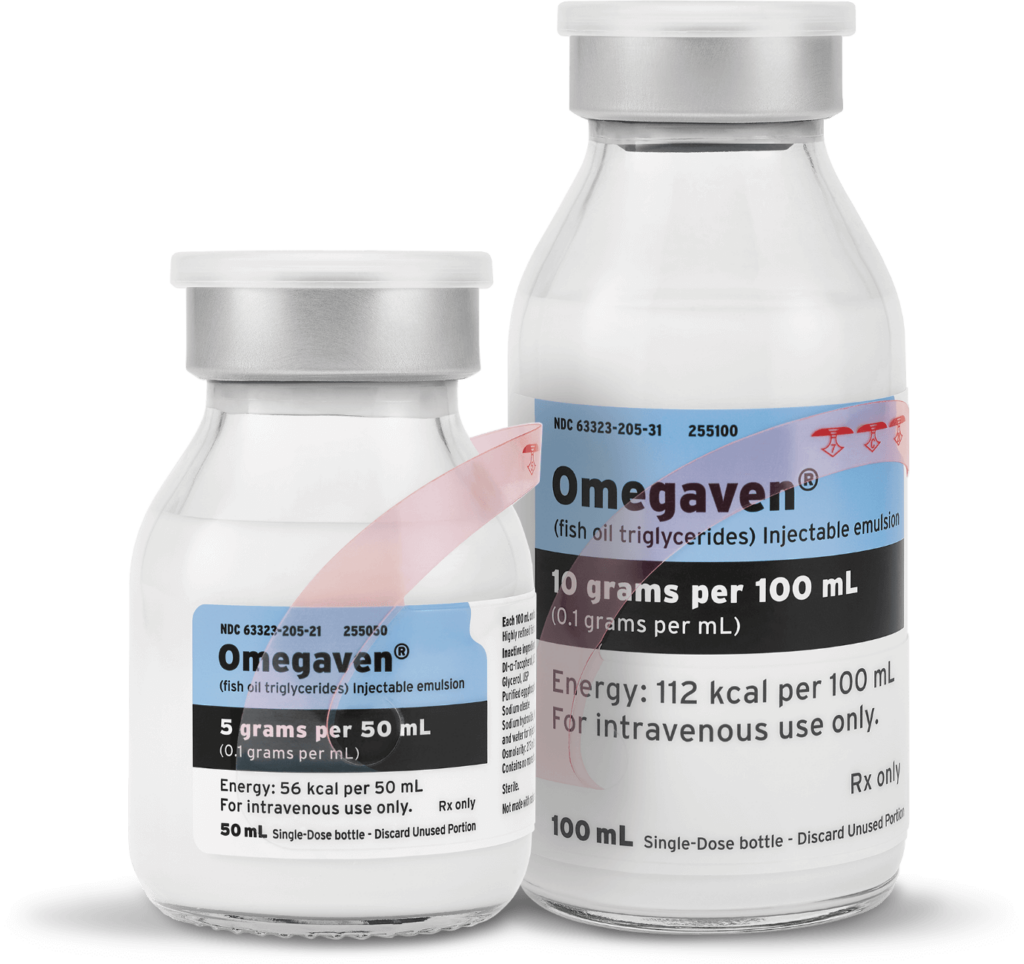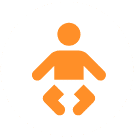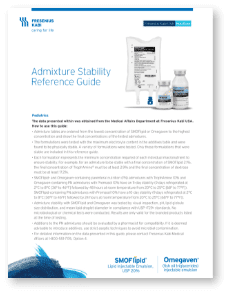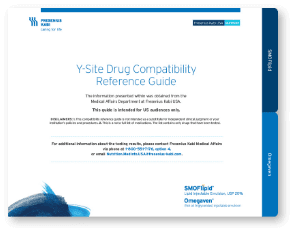

Innovation that nourishes with 100% fish oil1
Omegaven is a fish oil lipid injectable emulsion (ILE) for pediatric patients with parenteral nutrition-associated cholestasis (PNAC) that became commercially available in November of 2018; Omegaven was previously available only for compassionate care. Fresenius Kabi was widely aware of the need for this product to be more broadly available to pediatric patients and worked hard to secure the necessary clinical evidence to support FDA approval.
- Omegaven is a source of calories and fatty acids in pediatric patients with PNAC
- Fish oil is the newest type of lipid to be introduced into PN products
- Fish oil is rich in omega-3s
Features of Omegaven

- Patients receiving Omegaven achieved age-appropriate growth1,2
- Omegaven-treated patients experienced improvement in liver function parameters2
- Direct or conjugated bilirubin levels are lowered1,2
- Contains EPA and DHA
EPA and DHA (omega-3 fatty acids) are considered to be important for healthy development of infants due to their physiological roles3,4
-

May be considered conditionally essential for growth and development5,6
-

Important structural elements of cell membranes4
Indications and limitations of use
Indication:
Omegaven is indicated as a source of calories and fatty acids in pediatric patients with parenteral nutrition-associated cholestasis (PNAC).1
Limitations of Use:
Omegaven is not indicated for the prevention of PNAC. It has not been demonstrated that Omegaven prevents PNAC in parenteral nutrition (PN)-dependent patients. It has not been demonstrated that the clinical outcomes observed in patients treated with Omegaven are a result of the omega-6: omega-3 fatty acid ratio of the product.1
Understanding PNAC
PNAC is the onset of liver disease in the context of the administration of PN in patients with temporary or permanent intestinal failure.7 It is most commonly defined as direct or conjugated bilirubin greater than 2 mg/dL in patients who receive PN >2 weeks.8-11 Other terms commonly used include intestinal failure-associated liver disease (IFALD) and parenteral nutrition-associated liver disease (PNALD).
Incidence of PNAC increases with longer exposure to PN.11 The average incidence rate of PNAC in neonates and infants is 29.9%.11
Increased risk of PNAC may include prematurity, low birth weight, lack of enteral feeding, necrotizing enterocolitis, recurrent sepsis, and factors relevant to PN.11-13
KabiCare Patient Support Program for Parenteral Nutrition
Fresenius Kabi’s patient support program, KabiCare, offers online resources for claims appeals and billing as well as coding guides for parenteral nutrition.
Omegaven resources
Explore additional Omegaven materials by visiting our Resource Center.
For Consumers
OMEGAVEN (fish oil triglycerides) injectable emulsion, for intravenous use
IMPORTANT SAFETY INFORMATION
These highlights do not include all the information needed to use OMEGAVEN safely and effectively. To learn more about OMEGAVEN for your child, talk to your child’s healthcare provider. OMEGAVEN is available by prescription only. The FDA-approved product labeling can be found at www.freseniuskabinutrition.com/OmegavenPI.
What is OMEGAVEN?
- A fish oil-based intravenous lipid emulsion that is a source of calories and fatty acids in pediatric patients with parenteral nutrition-associated cholestasis (PNAC).
- Does not prevent PNAC.
- It has not been demonstrated that the clinical outcomes seen in pediatric patients are a result of the omega-6:omega-3 fatty acid ratio of the product.
- The hourly infusion rate should not exceed 1.5 mL/kg/hour
For Consumers
OMEGAVEN (fish oil triglycerides) injectable emulsion, for intravenous use
IMPORTANT SAFETY INFORMATION
These highlights do not include all the information needed to use OMEGAVEN safely and effectively. To learn more about OMEGAVEN for your child, talk to your child’s healthcare provider. OMEGAVEN is available by prescription only. The FDA-approved product labeling can be found at www.freseniuskabinutrition.com/OmegavenPI.
What is OMEGAVEN?
- A fish oil-based intravenous lipid emulsion that is a source of calories and fatty acids in pediatric patients with parenteral nutrition-associated cholestasis (PNAC).
- Does not prevent PNAC.
- It has not been demonstrated that the clinical outcomes seen in pediatric patients are a result of the omega-6:omega-3 fatty acid ratio of the product.
- The hourly infusion rate should not exceed 1.5 mL/kg/hour


